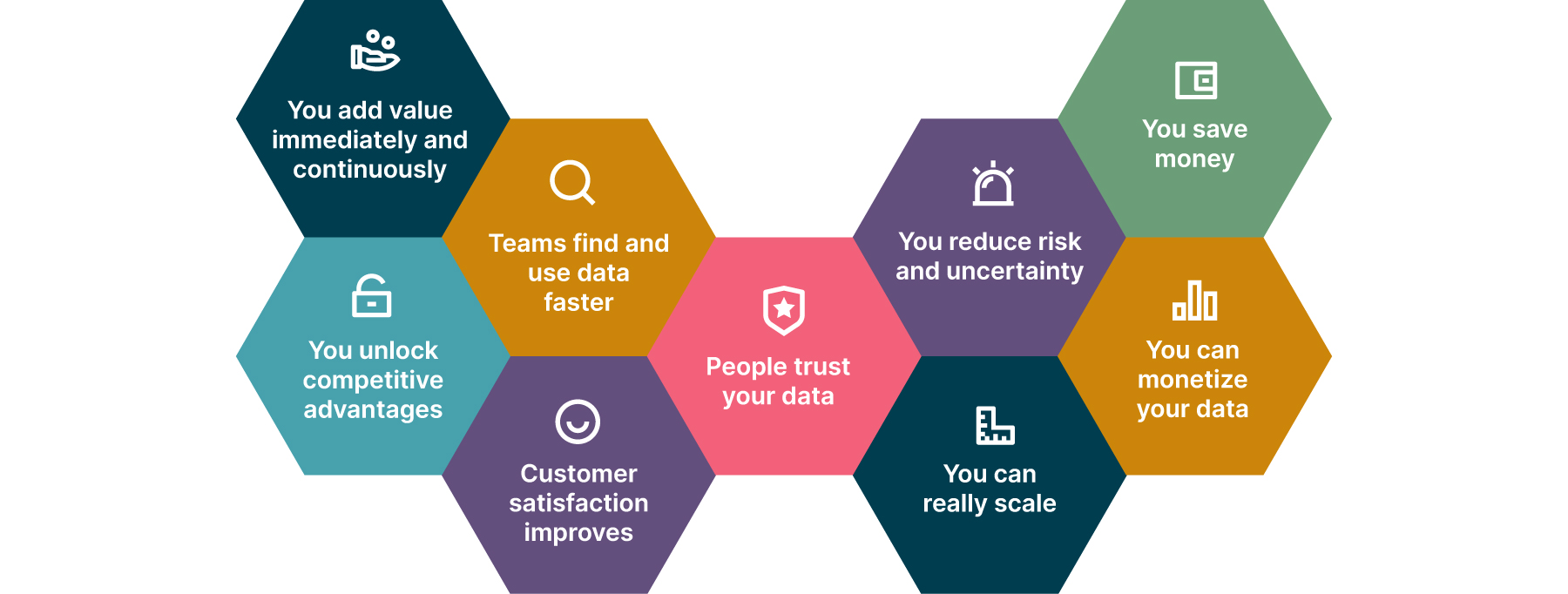In today's competitive landscape, leveraging data is no longer solely about efficient data handling; it's about harnessing data as a powerful product that drives innovation, empowers strategic decision-making, and fuels business growth. Imagine a world where your data transcends being a mere repository and instead evolves into a dynamic force that actively delivers immediate, measurable value for your teams and customers, catalyzing positive impacts on the bottom and top lines while uncovering fresh opportunities.
This article explores the fundamental concept of treating data as a product (DaaP) and its essential role in reshaping business strategies. Here, business leaders will uncover actionable insights to unlock the full potential of their data.
What does it mean to treat data as a product?
Treating data as a product involves applying principles of product thinking to the design, development, and utilization of data. It views data not merely as a static resource but as a dynamic and valuable product that meets specific needs, solves explicit problems, and provides tangible value to its consumers. While the term “data product” has been employed with different definitions, in the context of DaaP, data products — just like traditional products — are valuable and functional on their own, addressing specific business needs or goals. They encompass all the essential components needed for their utilization: not just data, but also relevant metadata, the code required to transform and present the data, governance policies, quality processes, and the infrastructure required to publish and operate it.
When data is treated as a product, it:
is converted into valuable information, so that it provides clear direction for problem-solving, decision-making, and action.
is presented to consumers in a secure, consistent, understandable and readily accessible manner, so that their needs are quickly and efficiently addressed.
meets consumers’ expectations regarding accuracy, completeness, and timeliness, so that they can use the data with confidence.
is Discoverable, Addressable, Trustworthy, Self-Describing, Interoperable, and Secure (DATSIS), so that it can quickly be integrated across your enterprise and is scalable with evolving business requirements.
Why organizations should invest in DaaP?
Do your teams struggle to find and use data effectively? Are governance and quality controls faltering, leading to errors and distrust in your data? Is the untapped potential of your data locked behind barriers, causing delays in insights and missed business opportunities? Are your existing processes becoming unsustainable as your data volume and demand grow? Is your organization investing excessive time and money to overcome inefficient data management practices? If those questions resonate with your experiences, it's a sign that your organization could benefit from adopting a data product thinking approach.
Embracing DaaP isn't just a technological upgrade; it's a strategic imperative that shapes how your organization harnesses its data. By implementing DaaP, you set the stage for a culture of compliant and scalable data-driven decision-making, innovation, and sustained growth. Implementing DaaP yields compelling advantages:


How is it different from treating data as an asset?
While data as an asset acknowledges data's value as a resource contributing to organizational growth and effectiveness, it predominantly focuses on collecting, storing, and safeguarding data for future use. This focus on future potential means that substantial effort is required each and every time you want to transform data from its theoretical value to its actual utility. In other words, “fit for every purpose” really means “fit for no purpose” - at least not without an additional investment of time and resources.
In contrast, data as a product operationalizes the value of data, emphasizing its immediate and continuous utilization, transformation, and delivery of value. DaaP involves packaging data in a manner that is tailored to the identified end-users' current needs (including how they want to consume it), resembling the delivery of a traditional product. This holistic approach enhances the data's utility and relevance and ensures that the data is not only available but also accessible and valuable immediately. So it’s not that treating data as an asset is bad —- it’s just not enough.
Is this the same thing as Data Mesh?
While data as a product stands as a fundamental principle within the Data Mesh framework, the product-centric approach of DaaP transcends the confines of particular frameworks. Prioritizing DaaP principles across diverse architectural frameworks substantially elevates data usability. This emphasis cultivates a seamless data ecosystem, empowering more impactful applications and analytics. Whether organizations implement a Data Mesh framework, a data fabric, or another innovative approach, focusing on the productization of data remains integral.
Ok, I see the value. Where do I start?
Recognizing the value is one thing, but kickstarting a DaaP implementation journey demands strategic leadership and concerted efforts. Taking the following actions will help pave the way for a successful transition toward treating data as a product, setting the foundation for your organization's data product-centric future.


1. Set a clear vision
Define the strategic goals and outcomes you aim to achieve by implementing DaaP
- Share this vision across the organization to unite teams and align departments toward a common objective.
2. Secure buy-in and sponsorship
Rally support from key stakeholders: executives, department heads, and IT leaders.
Drive reflective alignment, empowering stakeholders to connect advantages of DaaP with business objectives and goals.
3. Enable a cross-functional implementation team
Curate a diverse and skilled team of individuals from various departments and business units. Include expertise in product management, engineering, data science, business domains, security, compliance, data governance, analytics, and change management.
Aim for a collaborative blend of hard and soft skills and expertises that align with your organization’s goals.
Redefining leadership: Orchestrating data's evolution as a product
As your organization progresses through the foundational stages, your role as a leader becomes pivotal in enabling implementation teams to drive the subsequent actions essential for a thriving DaaP implementation. Your commitment to the DaaP vision is vital in securing resources, aligning strategic objectives, and championing a culture conducive to a product-centric approach to data.
Of course, you may not be involved in day-to-day operations as your teams work through assessment and discovery tasks, defining use cases, developing roadmaps and policies, and executing on change management and delivery. However, your advocacy for DaaP in organization-wide communications will foster a shared understanding and commitment to successful outcomes. Your support empowers teams to navigate challenges, make informed decisions, and efficiently execute the defined roadmap. By monitoring progress and providing strategic guidance aligned with your evolving business landscape, you ensure that the DaaP implementation remains on track and effectively contributes to your organizational goals.
Tying the knot
Put simply, DaaP is the application of proven product and engineering principles to data. By mirroring successful product development methodologies, organizations gain the agility and adaptability central to harnessing timely data-driven insights. DaaP stands as a cornerstone in any landscape of data management methodologies, intertwining seamlessly with concepts like Data Mesh and data fabric, enabling DaaP within organizations to lay a robust foundation, orchestrating a sustained journey toward valuable insights and growth, regardless of your architecture.
In order to successfully adopt DaaP, the focus shifts to you as a change agent for your organization. First, you must ensure your business goals and objectives are clear and well-defined. Be explicit about what problems you expect DaaP to solve and the opportunities you expect it to unlock. Make sure those problems and opportunities are not just identified but also validated within your organization.
After laying the groundwork, move on to securing resources and fostering a culture centered around a product-centric data approach. This is about rallying teams around the common vision and approach. And as the transformation begins, be the guiding leader who navigates teams through challenges, assists them in making informed decisions, and supports them on the roadmap to success.
By seizing the opportunity to serve as a catalyst, you are opening the door to a new era where data isn't merely an asset — it's the driving force behind innovation, growth, and achieving your mission. As you embark on leading your organization into this thrilling new chapter of data-driven excellence, I trust you'll navigate it with confidence and strategic acumen.



















